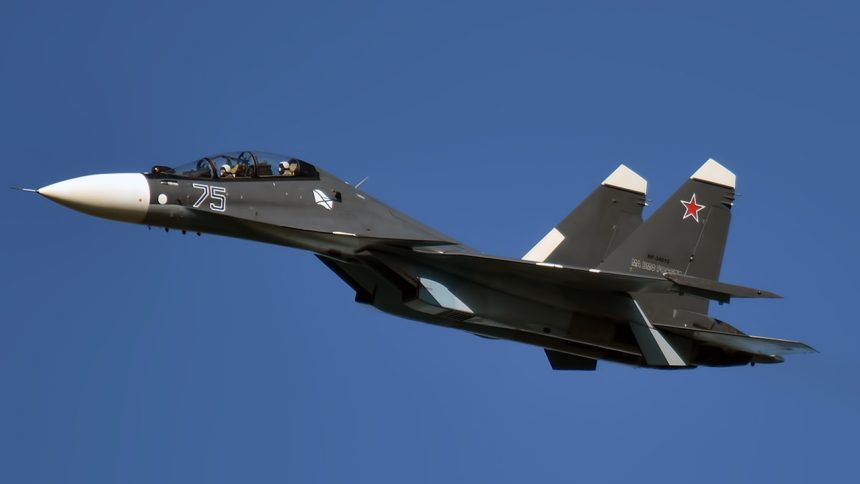A brief incursion inside NATO’s airspace occurred on the same day Washington imposed new sanctions on Russian oil giants Rosneft and Lukoil, amid growing tension between the U.S. and Russia.
A Russian Su-30 fighter jet and an Il-78 aerial refueling aircraft violated Lithuanian airspace on Oct. 23, 2025, entering approximately 700 meters into the country’s territory and remaining for about 18 seconds before turning back toward the Kaliningrad region. The two aircraft were reportedly conducting air-to-air refueling training when the incursion occurred.
In response, two Spanish Air Force Eurofighters assigned to the NATO Baltic Air Policing mission were scrambled to intercept and patrol the area. Lithuanian President Gitanas Nausėda condemned the violation, describing it as a gross breach of international law. He added that such incidents have been increasing recently, not only in Lithuania, and stressed that the government cannot fail to react. The Lithuanian Ministry of Foreign Affairs summoned a representative of the Russian Embassy in Vilnius and delivered a formal note of protest.
The Russian SU-30 and IL-78 aircraft crossed about 700 metres into Lithuanian territory near Kybartai, staying in our airspace for 18 seconds.
This incident once again shows the reality of our region. Together with our Allies, we must keep strengthening our defence capabilities. https://t.co/njpFxMUoMM
— Lithuanian MOD 🇱🇹 (@Lithuanian_MoD) October 23, 2025
Prime Minister Inga Ruginienė confirmed that the situation was fully under control, praising the rapid response of Lithuanian and allied forces. “Our services acted with precision,” she said, emphasizing that Russia is behaving like a terrorist state, disregarding international law and the security of neighboring countries. “However, such actions will not affect us. Lithuania remains strong, united, and ready to defend itself.”
This evening, Russian military planes violated Lithuanian air space. This is a blatant breach of international law and territorial integrity of Lithuania. Once again, it confirms the importance of strengthening European air defence readiness.@LithuaniaMFA will summon Russian… pic.twitter.com/0GS6OrKaRx
— Gitanas Nausėda (@GitanasNauseda) October 23, 2025
The airspace violation came on the same day the United States announced sweeping sanctions against Russia’s two largest oil companies, Rosneft and Lukoil, marking a sharp escalation in Washington’s strategy toward Moscow. The decision followed the postponement of a planned summit between Presidents Donald Trump and Vladimir Putin, seen as a sign of growing frustration in the White House over Russia’s stance on the war in Ukraine.
Moscow reacted defiantly, with Putin declaring that Russia would never bow to U.S. pressure and warning of an overwhelming response to any military strike within its territory. The timing of the airspace violation, coinciding with heightened diplomatic and economic tension, has raised questions about whether it was a deliberate show of defiance or a navigational error amid increasingly strained U.S.–Russia relations.
Previous incidents
The incident involving the Su-30 comes roughly one month after Russian MiG-31 Foxhound jets violated Estonian airspace: on Sept. 19, 2025, three MiG-31s of the Russian Aerospace Forces entered Estonian airspace near Vaindloo Island, remaining inside for about 12 minutes. The fighters initially flew on a course toward Estonia’s capital Tallinn before circling within Estonia’s airspace, where they were eventually intercepted by two F-35A Lightning II of the Italian Air Force deployed to Ämari Air Base, Estonia, to support NATO’s Baltic Air Policing mission.
That episode reignited debate across social media and defense circles about NATO’s air policing protocols and rules of engagement in case of intrusion. In fact, as explained in detail, that incident, which occurred amid a wider pattern of drone intrusions over Poland and Romania, prompted some to question whether the Alliance should reconsider its threshold for kinetic response in the Baltic region. Others argued that maintaining a posture of restraint remains essential to prevent miscalculation and escalation along NATO’s eastern flank.
Many observers compared the MiG-31 episode to the 2015 Turkish shootdown of a Russian Su-24, which crossed into Turkish airspace for just 17 seconds before being downed by an F-16. However, the two events differ profoundly in both context and intent. The 2015 shootdown occurred at the height of the Syrian conflict, following weeks of repeated violations and radar locks that Ankara had explicitly warned would no longer be tolerated. The Baltic Air Policing mission, by contrast, operates under peacetime deterrence rules that emphasize identification and escort rather than engagement. NATO fighters are authorized to shadow, not to strike, unless directly threatened or ordered under an Article 5 scenario.
Still, the frequency of Russian airspace violations across the Baltic region has increased, suggesting that Moscow is deliberately probing NATO’s readiness and response thresholds. Each incursion provides valuable data for both sides: for Russia, on reaction times and patrol procedures; for NATO, on patterns of activity emanating from Kaliningrad and the western military district. These episodes also serve a broader strategic function: signaling resolve and testing the Alliance’s cohesion under pressure.
For now, allied officials continue to stress restraint and coordination as key elements of credibility. The quick scramble and professional intercept by Spanish Eurofighters once again demonstrated the value of the Baltic Air Policing mission and the integration achieved through systems like BALTNET and the Combined Air Operations Centre in Uedem. Yet as air activity intensifies and diplomatic relations deteriorate, the risk of miscalculation grows…









